The English Distillery was founded in 2006 by James Nelstrop and his son, Andrew.
An English whisky distillery isn’t peculiar these days. There are over 60 of them. Open a whisky distillery in England in 2026 and you’ll barely get a headline beyond the local paper.
But in 2006, it was all so different. There wasn’t another registered English whisky distillery*. From a quiet corner of Norfolk, the Nelstrops helped kickstart an entire category.
Last week, Andrew and his wife Katy (marketing director), plus sales director Mike Fisher, hosted a group of whisky writers at the beautiful site near Roudham to learn about a coming age of story that isn’t just marked with new releases, but with a reminder: England’s whisky future began here.

We visited The English Distillery last week. Here’s what we thought.
The coming of age of English whisky
It’s hard to imagine now that at the beginning of the 21st century, English whisky was more museum piece than movement. The last known whisky distillery, Lea Valley, switched from whisky to gin production in 1901 before being destroyed by a fire four years later.
England remained silent on the subject for over a century until The English Distillery lit the stills once more. James Nelstrop’s lifelong dream of turning his crop into whisky owes something to a throwaway comment by his father that stuck with him: “It’s a shame all this barley has to go to Scotland to be turned into whisky.”
We’re the first press invited here since 2009. Andrew’s mum made sandwiches then. His dad, who sadly passed in 2011, didn’t really care about marketing, PR, all that nonsense. He just wanted to make world-class whisky to share with his mates. That mentality was taken forward by Andrew, who leads the distillery today.
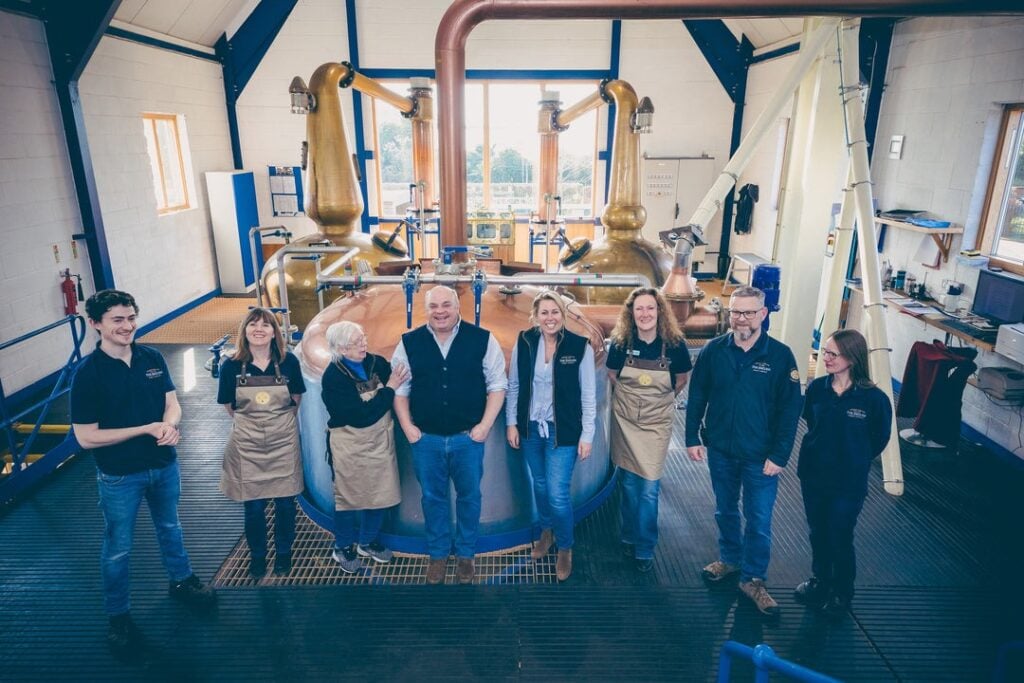
The English Distillery team in the stillhouse
St George’s Distillery and not liking whisky
After a lifetime in agriculture, from Lincolnshire to Australia to Norfolk, James knew all about the finest English-grown malt. The family can trace their lineage back to 1335, when William Nelstroppe was recorded as farming in Yorkshire. But branding? Less so. You might recall for a time, this company was known to many as St George’s Distillery. Andrew explains that St George was simply meant to be a fun name for the address.
But traders, brokers, buyers, and retailers came to know the distillery by the name and that put the brand on a collision course with a Californian outfit of some repute. The first letter from an American law firm was ignored, but the fourth wasn’t. The distillery address was officially changed four years ago.
Andrew, meanwhile, didn’t even like whisky when The English Distillery started. A turning point came from a persistent bartender who poured him an 18-month-aged spirit in a wine cask. He encouraged adding water. It opened up the drink and Andrew’s perspective. The man now leading the first modern English whisky never looked back.
How The English Distillery makes whisky
The name of the game here at The English Distillery is turning local ingredients into whisky using slow processes and traditional equipment.
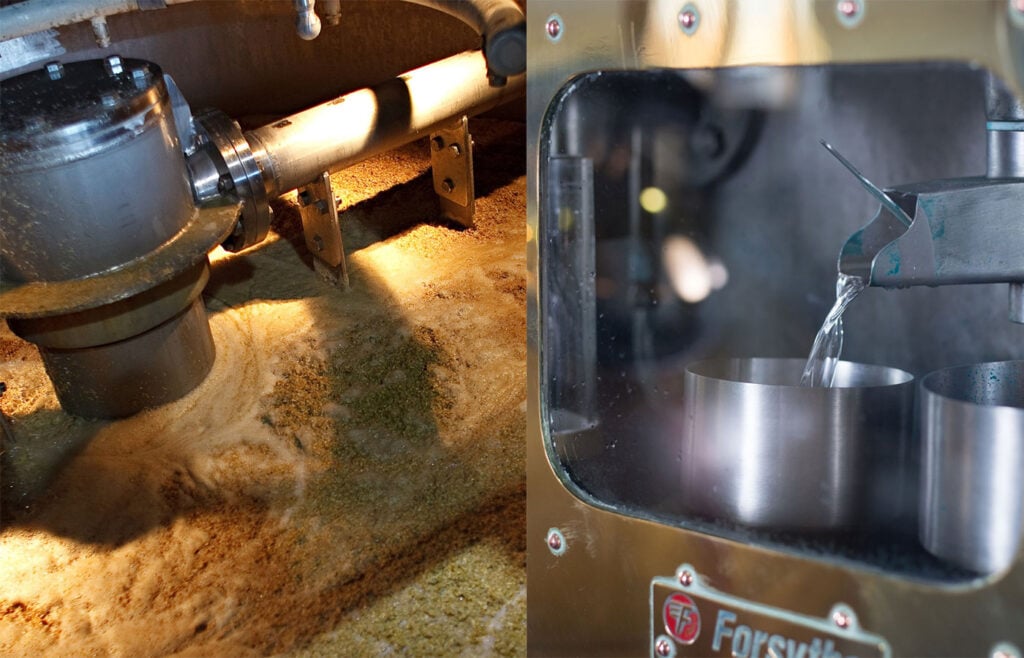
Let’s walk through how English whisky is made here
Local ingredients: water and barley (peated and unpeated)
It all starts with pure water drawn from the Breckland Aquifer, a permeable rock that stores groundwater directly beneath the distillery. This chalk aquifer pumps out hard water all year round, rich in minerals like calcium and magnesium. These qualities are often credited with adding character to whisky, as the way these minerals interact during fermentation and distillation can accentuate the sweetness and enhance the texture of the spirit.
As for grain, The English Distillery is spoiled. Norfolk is the UK’s premier barley-growing region, and there’s plenty grown locally in Suffolk too. The distillery has previously used barley from Nelstrop family farms in Lincolnshire as well. Wherever the grain comes from, The English Distillery insists on having full traceability. You’ll see that becomes a real theme.
The malting process is the only thing that doesn’t happen on site, and that’s because renowned maltsters, Crisps, are a short drive away in Fakenham. It provides both peated and unpeated malt here, the former to 50-65ppm and peated whisky makes up about a quarter of production here.
The English Distillery goes through one tonne of Laureate barley a day in its fine sturdy mash tun and runs typically four to five days a week. Andrew tells us that 11 years of research had gone into a barley strain that could improve on Laureate, but the spring barley fell victim to mill rot. A good reminder that whisky begins with agriculture…

The stillhouse
Slow processes and traditional equipment
The stillhouse was built by Forsyths, with 26 people working over six and a half weeks to set up the entire thing. It’s clean, smart, efficient and has everything you need. There was no compromise over any of the equipment as the Nelstrops knew they were only interested in making whisky, not gap-year white label spirits.
On one side of the mash tun are two 750-litre washbacks, which ferment for an average of about 104 hours, but typically they aim for 96 hours. Classic Fermentis SafSpirit™ M-1 yeast is used now, but The English Distillery’s first whisky maker, Iain Henderson (of Laphroaig fame), had favoured a live bread-making yeast that was used until the company stopped delivering that strain.
Walk the other side of the mash tun, and two gleaming copper pot stills greet you, a 2,750-litre wash still and an 1,800-litre spirit still. The shape is towards the dumpy side rather than tall, and the lyne arms descend to accentuate the oiliness and weight of the spirit. After the second distillation, they’ll have a new make spirit around 72% ABV. It’s very cereal-led in character with bright fruitiness and lacks the peppery abrasives of others I’ve tasted.
The cooling water used during distillation runs in a closed-loop system, returning to the ground after use and making the process over 90% more efficient than traditional methods, while slashing groundwater usage by 94%. Spent grains (draff) are sent to feed local dairy herds, and leftover liquids are used as fertiliser on neighbouring farms. Even the land works hard. The 10-acre site is planted with cricket bat willows, which help capture carbon, slow rain run-off, and create habitats for local wildlife.
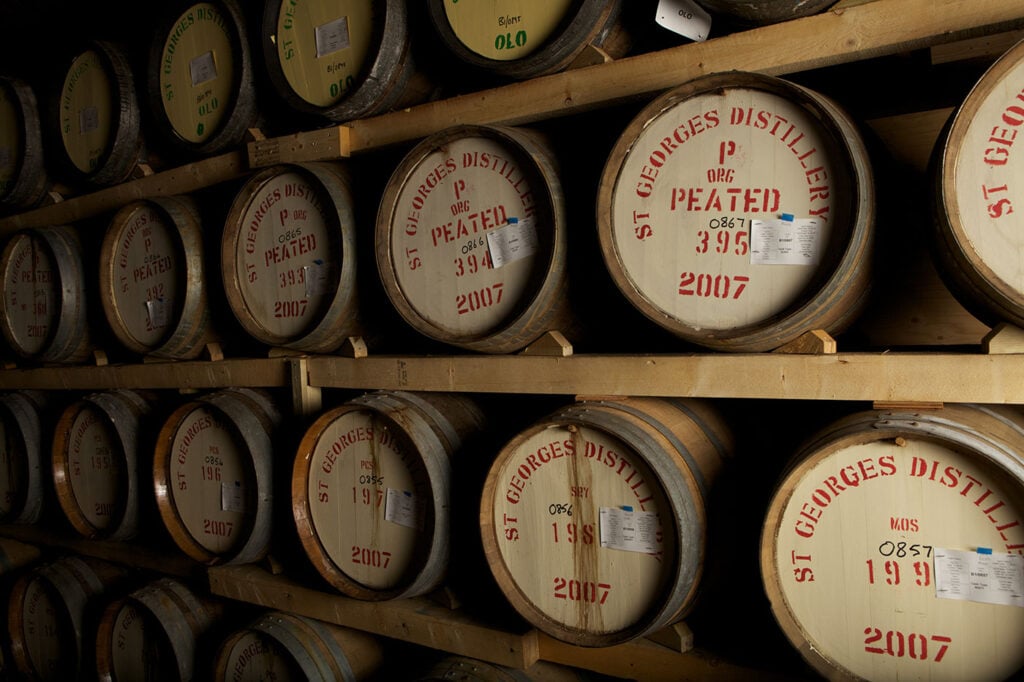
Peated and unpeated whisky is produced here
Casks and maturation at The English Distillery
Roughly 6,000 casks of whisky are maturing on site. The majority of barrels here are American oak Jim Beam casks, favoured for their consistency. They’re shipped directly after use, and while they could get as much as 10x more in a container if the casks were broken down, this method lacks the traceability and integrity of barrel quality that the team are striving for.
There’s a raft of different wine casks visible in the warehouse too, from sherry (from Miguel Martin’s fine cooperage) to Madeira, and Burgundy. Even local winery Burn Valley has provided three casks. But The English Distillery doesn’t really do finishes. The vast majority of casks here are for full-term maturation. If a cask is reused, it tends to be for a more comprehensive secondary maturation. Andrew says he’s not a fan of the splash-in and empty method.
Over the last few years, the team has worked hard to ensure that it knows the full lifespan of each cask they use. A lesson learned after purchasing rum casks of unknown origins early on. They will season casks on site themselves. We see a row of rum barrels, filled with a blend of four different rums from Jamaica (one high ester) that have been maturing here for a decade. Perhaps they’ll sell that rum one day, but its purpose is to give them a seasoned cask with full traceability.
They really do love that word. Andrew tells us about producing a ginger liqueur with Bodrum ginger supplied by a friend. He knows which farmer grew the ginger and which field it came from.

Do visit the birthplace of England’s whisky renaissance when you get a chance
New warehousing, private cask preference, and tasting the Angel’s Share…
The English Distillery also hold casks for other companies. Roughly one in five casks on site belong to another English whisky distillery. A new warehouse (in Suffolk) will see all of that move, so everything here is homemade.
We start in Warehouse 1, where traditional pallet racking is used. Casks here are stored upright on wooden pallets, the old-school way that works, but does limit flexibility. That system is slowly being replaced, as seen in Warehouse 4, by a mix of “Diageo-style pallets,” which can hold six bourbon barrels horizontally on a rack (great for airflow and access), and a new in-house innovation: bright red metal racks that can hold various cask sizes and allow them to be stored on their sides**.
Shipping containers hold casks for a while and become extraordinary hotboxes of whisky vapour. Walk in and you can physically taste the Angel’s Share in the air. That was some experience. I also enjoyed hearing Andrew talk about private casks, which there are very few of, due to his displeasure with people buying casks for investment purposes. He says he reckons he talks 9 out of 10 people from purchasing.
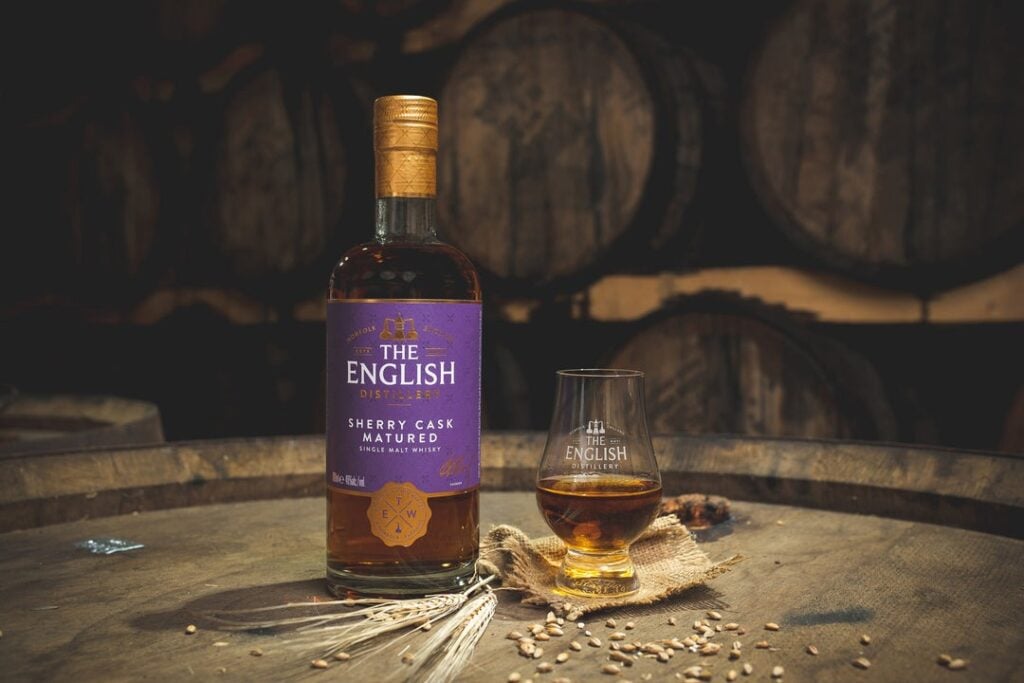
World’s Best Single Malt Whisky at the World Whiskies Awards 2024
How England’s oldest whisky distillery is leading its new era
That’s very much a reflection of the way things are done here. The commitment to quality extends to the distillery’s sustainable energy approach, with solar panels providing about 90% of the production power, or 30% of the entire site (which also includes a charming restaurant, The Grain). These solar panels aren’t on the roof. Andrew is fastidious about maintenance and prefers them to be ground-mounted for easier cleaning.
The distillery recently took home the award for World’s Best Single Malt Whisky at the 2024 World Whiskies Awards for The English Sherry Cask. It’s vindication, if it was needed, that England’s oldest whisky distillery is on the right track.
“We remain a family business with the aim to build a legacy, not an exit strategy,” we’re told. “We are proud to have breathed new life into English whisky distilling, and we will continue to set the standard for generations to come”.
The enthusiasm for English whisky and what goes into its production is palpable here. Giving a shit is the bedrock of integrity. It gives you a platform for good whisky because you care about getting every part of the process right, and you care about the people drinking it, not just that people are drinking it. This is a distillery working hard to make great whiskies that aren’t hard work. No gimmicks. No hopping on trends. Nothing dumbed down. They care about where things come from. How they are maintained. And that the whisky can speak for itself.
An approach which reflects in the quality of said whisky, three of which we tasted. Let’s wrap things up with some reviews.
The new era of The English Distillery releases
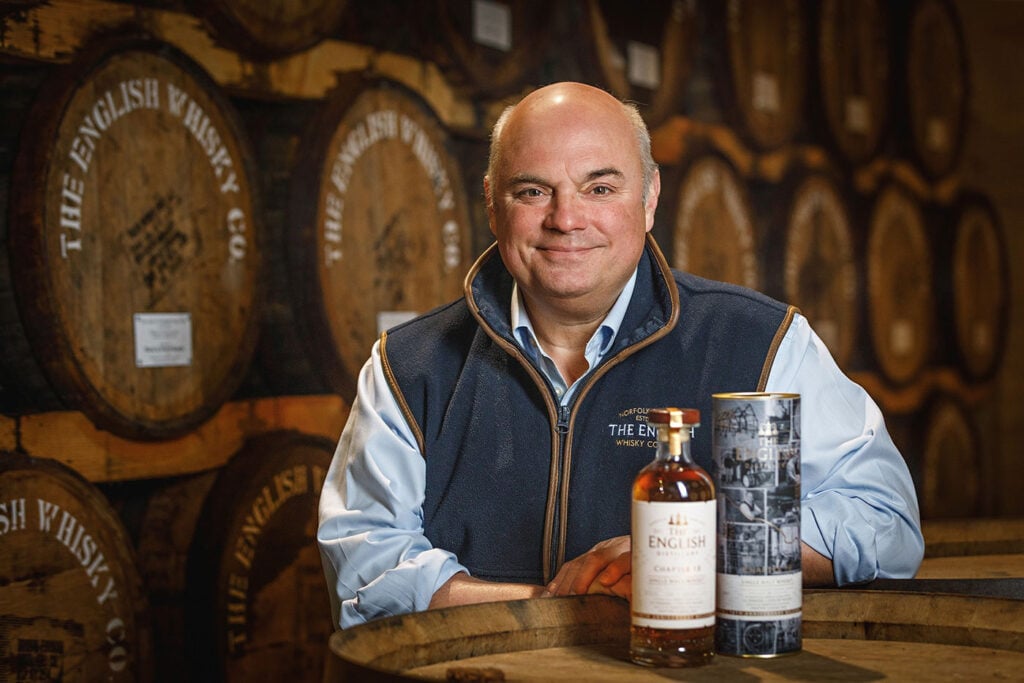
The English Chapter 18 is a very fine whisky, and we rated it highly
The English Chapter 18 18th Anniversary Release Whisky
Chapter 18 is a blend of single malts aged between 10 and 18 years (a fairly even split between 10, 12, 14, 16, and 18 year old) drawn from bourbon, sherry, and new oak casks, including both unpeated and lightly peated spirit. It was released on 7 June, which would have been James’s 80th birthday.
Fisher explains they could have priced it higher, as much as £110, but they’re keen for people to actually drink their whisky. They used to do sample bottles with The English Founders’ Private Cellars range so people could taste the liquid they were collecting. They then became collectables, and people stopped drinking them. You do what you can.
Nose: Pear drops, custard, bonfire smoke, dried mango, gingerbread, orange peel, soda bread, and dates.
Palate: Fruitcake, vanilla, nutmeg, tropical fruit, banoffee pie, spent match, oak char, juicy barley, and marzipan.
Finish: Oaky, creamy, elegant and with more tropical fruitiness and faint hints of aromatic spice.

Last year’s Founders Private Cellar edition
English Founder’s Private Cellar 18 Year Old
The latest release from The English Founders’ Private Cellars range, aged in rum casks. The first 6-8 years were in a rum cask that didn’t live up to traceability standards, so it was moved into rum casks that the distillery fills themselves for 10-12 years. The launch is 11 September.
ABV: 55.4% ABV
Nose: Caramel over vanilla ice cream, estery tropical fruit (guava, passionfruit, pineapple, melon, banana), cake batter, cinnamon, pennies, melted milk chocolate, and dried grass.
Palate: Rum and raisin ice cream, custard, nutmeg, tropical fruit salad, buttery toffee, marmalade, a touch of anise, and toasted almonds.
Finish: Settles with aromatic spices, banana, coconut, and clove.
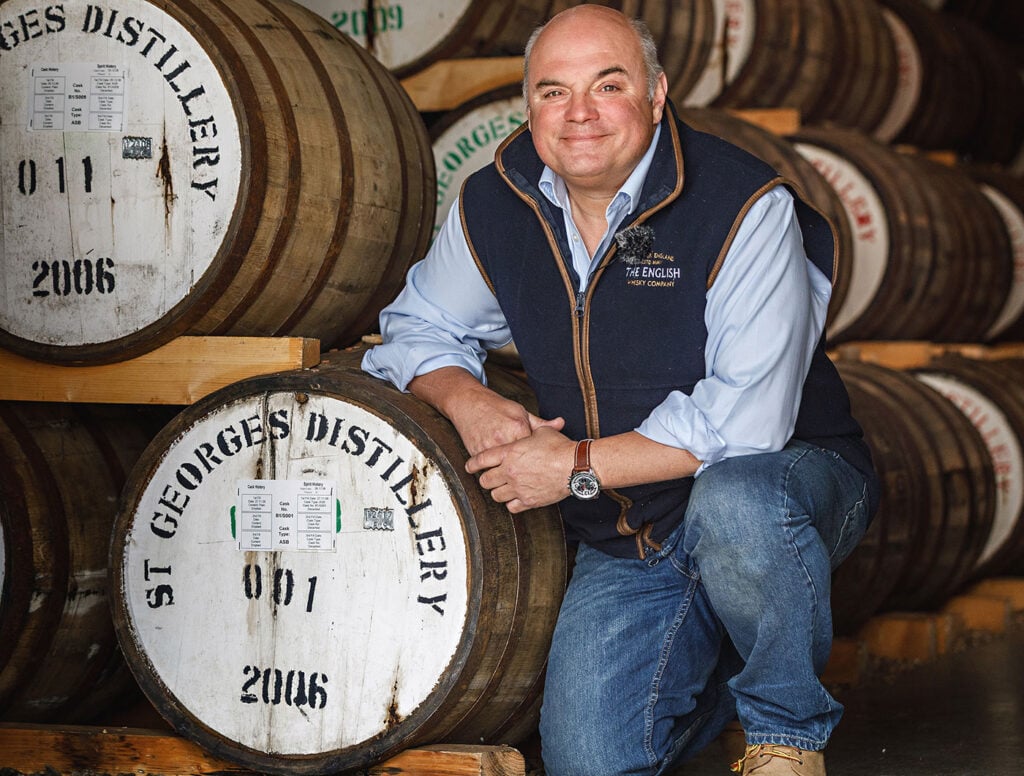
The English Cask 001 with Nelstrop
The English Cask 001
The highlight was the long-awaited release of Cask 001. Distilled in 2006, the cask was the inaugural filling. The first English whisky in more than 100 years. Norfolk’s own Langham Glass hand-blown decanters add to each bottle’s value as a collector’s piece. It weighs 4kg. Yes, I was terrified I would drop it.
There’s about 180 bottles in the cask, a third of which will be released. It was pretty much all aged in a first-fill Jim Beam bourbon cask, save for one year it spent in an a sherry cask from Miguel Martin, a hogshead blend of PX and oloroso. Andrew is open about the fact that this won’t be instantly recognisable to fans of the distillery today, explaining that the first whisky a distillery makes reflects your early days of experimenting and discovering.
The launch is on 25 September and the RRP is £3,000.
ABV: 54.1%
Nose: Brandy snaps, firewood, stewed plum, toffee apples, soy sauce, rose, oak tannins, and chocolate (sometimes mint, sometimes orange, sometimes Bounty). With time, it’s very sticky toffee pudding with dates.
Palate: Cherries, almost root beer, marble cake, ginger, toasted nuts, mocha, tinned pear and peaches… It’s an interesting blend of bourbon and sherry and feels much older than it is.
Finish: Bonfire smoke, treacle, oak char, and sticky dates.
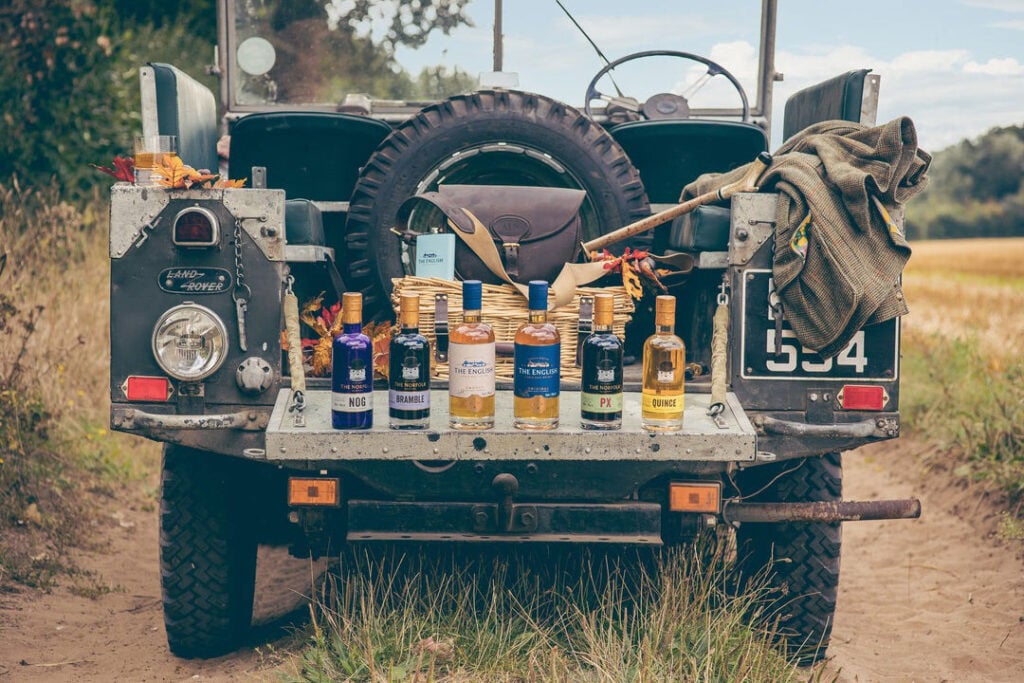
Norfolk is the home of the first English whisky
*Hicks and Healey made whisky in 2003. This collaborative effort between Healey’s Cider Farm and St. Austell Brewery was launched after The English Distillery’s first release, however.
**Storing casks sideways is said to help keep the bung (lid) moist, reduce the risk of evaporation and leakage, and can promote better interaction between the spirit and the wood.
